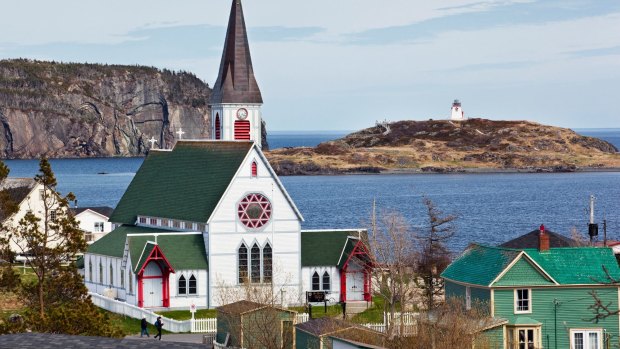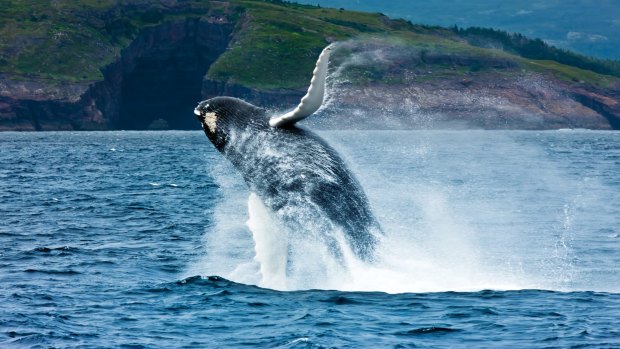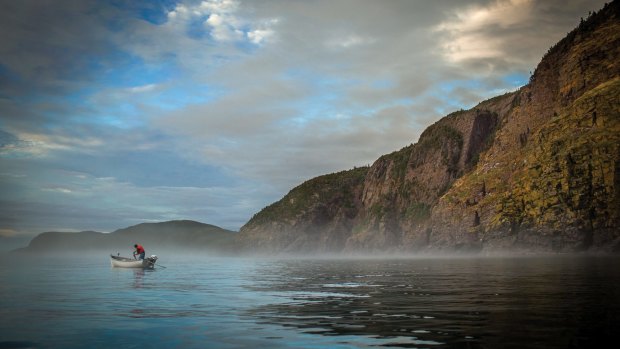This was published 7 years ago
Trinity, Newfoundland: Canada's isolated peninsula with heart and soul

St. Paul's Anglican Church (foreground) and Fort Point Lightouse (background).Credit: Robert Chiasson
Marieke Gow sits on the front steps of her marigold-orange saltbox style home – it overlooks other boldly painted buildings and a harbour brimming blue with Atlantic seawater – and says she has never met a Newfoundlander who did not wish they were home. Like the town of Trinity, this attachment to place has 500-year-old foundations. Incubated for centuries in geographical and social isolation, the province of Newfoundland and Labrador is today a living museum with arms wide open to those of us "from away".
Although only a first-generation Newfoundlander and Labradorean, Marieke misses "the smell of the air, the sound of the foghorn and the call of the seagulls" when travelling. And not just generic versions, but "my foghorn, my seagulls". She describes them as anchors. With a coastline that, if straightened, would stretch back and forth across greater Canada, such nautical accoutrements have long been integral to this easternmost province.
"We're Newfoundlanders first, Canadians second," declares Kevin Toope that evening at Rocky's, the no-frills bar Kevin Spacey hung at during the filming of The Shipping News. I've just seen the play No Man's Land at Trinity's Rising Tide Theatre about Newfoundland's involvement in World War I. Kevin, who has led historical walking tours of this former boatbuilding town for "18 summers", tells me Newfoundland was still part of the British Empire then and only joined Canada in 1949.

Whales and icebergs are a regular sight around many parts of the Newfoundland and Labrador coastline.Credit: Wayne Barrett
Yet the provincial pride has far deeper roots than that.
After Italian mariner, merchant and explorer Giovanni Caboto first sailed over from the Irish Coast in around 1500, abundant cod was discovered in Conception Bay, at the Grand Banks, and off Trinity here on the Bonavista Peninsula. Schools so dense, Caboto recorded, you could barely row a boat through them. Even today, when locals say fish they are actually visualising cod.
What followed was like a slow motion gold rush: Europeans sailed the Atlantic to settle and pillage the salty resources of this New Found Lande with minor consideration for those already there. One indigenous group, the Beothuk, died out by the mid-1800s.

Many Newfoundlanders appear to be most comfortable when they are out on the sea.Credit: Newfoundland & Labrador Tourism
The newcomers themselves suffered under corrupt and oppressive governments and greedy merchants. In desperation, many established tiny settlements in hidden coastal inlets and lived hard and isolated lives surviving off the land and sea, blanketed by snow every winter. When Britain and France were at war, these outposts had to defend themselves against French military, often unsuccessfully. Then in 1846 a fire destroyed much of the capital, St John's, followed by a cholera epidemic, followed by another fire worse than the first.
"Built on tragedy, we were," Nick Dawe had said with a grin as we reeled in our strictly controlled quota of cod on a mauzy afternoon – foggy and damp – on Conception Bay back when I had just arrived in the province. Much of Newfoundland and Labrador's slang comes from West Country dialects and Gaelic. "Where y'longs to?" means where are you from? "Who knit ya?" is who are your parents?
Dawe's accent is so strong that as he spun the tale, when we motored past Kelly's Island, of the murderous Captain Henry Morgan who buried his treasure there between slain crew so nobody would dig for fear of the tuberculosis multiple graves suggested, I was transported.
Newfoundlanders, he also explained, are either townies or baymen. And, although St John's has old world charm, I find the real Newfoundland and Labrador is in the rural countryside and seascape. Like seals, baymen tend to be stocky and even a little graceless on land but, once in their natural environment out on the sea, they transform and become beautiful.
I asked this 20-something nautical science student, as he stood as steady in the swell as if it were a solid extension of the low-profile terrain cradling the bay, about how it felt to grow up out here in a fishing village.
"Loved it."
Conception Bay is just outside St John's and, on the way back to town for the night, I stopped at Cape Spear. The province's oldest surviving lighthouse stands there, like a vertical portal to the past, on North America's most eastern point of land. When the 1839 structure was restored they counted 167 layers of wallpaper. The birch barrels on the top floor would have held sperm oil, molasses and oatmeal. One guide held up a piece of wood whittled into a ball within a cage.
Bonavista Peninsula is three hours north of St John's and, just down the road from Trinity, is the town of New Bonaventure.
Bruce Miller sings Salt Water Joys with surprising unselfconsciousness for a middle-aged white man as he guides the eight-metre boat alongside ancient sea cliffs as bald eagles call and puffins scatter. If you live on Trinity Bay, icebergs and whales are not strange sights here either. These days, this former cod fisherman gets his joys showing CFAs – come from aways – where his relatives and ancestors lived and thrived on an outlying island.
When Newfoundland entered the Canadian Confederation in 1949 it "was the beginning of the end for all of these small communities", Bruce explains as we slip into the forgotten harbour of Ireland's Eye. Not so unlike forcing people onto reservations, the federal government made villagers abandon their homes and relinquish their virtually self-sustaining lifestyles to centralise closer to services.
We gasp when Bruce holds up a 1940s photograph of this exact spot when there were scores of cottages and carpets of cod drying on the wooden flake and 157 residents busy living.
Ottawa also allowed international fleets to overfish areas like the Grand Banks until, one morning in 1992, a moratorium was declared on the Atlantic cod fishery. Over the next decade 60,000 people left the province in search of employment. But Bruce Miller could not bear to stay away and got innovative; seeing the world outside the only one he had ever known opened his eyes to how achingly beautiful the Bonavista Peninsula is and he returned to launch Rugged Beauty Boat Tours.
When Marieke Gow's mother, Tineke, first arrived on the same peninsula she saw Trinity's potential through European eyes and was the first in the area to offer queen-sized bed accommodation. For 25 years Artisan Inn have been "selling the chance of living in history for a night".
So a new industry has spawned, is growing and people are slowly coming home. But even though tourism has become the lifeblood of many towns such as Trinity, nobody seems to be losing sight of their true selves in some fog of commercialisation.
"There's a heart to this community," says Marieke, who works alongside her mother. "People only break into your house here to give you a gift."
TRIP NOTES
MORE INFORMATION
newfoundlandlabrador.com; au-keepexploring.canada.travel
GETTING THERE
Air Canada flies daily from Sydney to St John's via Vancouver, Toronto or Montreal (Melbourne passengers can fly Qantas to Sydney to connect); see aircanada.com, qantas.com. A visa waiver is now required to enter Canada; see cic.gc.ca.
STAYING THERE
Artisan Inn, 57 High St, Trinity, offers rooms, vacation homes and advice on everything to see and do in the surrounding area. See trinityvacations.com.
SEE + DO
Trinity Historical Walking Tours; see trinityhistoricalwalkingtours.com. Rugged Beauty Boat Tours; see www.ruggedbeautyboattours.net. Ocean Quest Adventures are based in Conception Bay; see oceanquestadventures.com.
DINING THERE
The Twine Loft, 57 High St, Trinity, see trinityvacations.com; Fishers' Loft Inn, Mill Rd, Port Rexton, see fishersloft.com; Bonavista Social Club, 2 Longshore Rd, Upper Amherst Cove, Bonavista, see bonavistasocialclub.com.
Elspeth Callender was a guest of Newfoundland and Labrador Tourism and the Canadian Tourism Commission.
FIVE MORE PRETTY OLD TOWNS TO VISIT IN NEWFOUNDLAND & LABRADOR
BATTLE HARBOUR
Five per cent of the province's population live in Labrador even though its area is more than double that of the island of Newfoundland. Experience traditional song, dance and recitation while staying in this former salt fish capital.
BRIGUS
Only an hour by car from St John's, this coastal town in the Avalon region wears its English, Irish and Welsh heritage in the form of stone walls, winding lanes and Victorian buildings. Blueberry festival held in mid-August.
RED BAY NATIONAL HISTORIC SITE
Red Bay Basque Whaling Station, part of the Labrador Coastal Drive, was recently named a UNESCO World Heritage Site. On nearby Saddle Island are the remnants of whale processing machinery.
TILTING
Tilting is one of Fogo Island's 11 communities. World's End Theatre Company hosts an annual festival there and a Shorefast Foundation state of the artist-in-residence building, Squish Studio, is on its outskirts.
TWILLINGATE
The so-called Iceberg Capital of the World is on New World Island but accessible by road from the north-eastern shore of the island of Newfoundland. Fish, Fun & Folk festival is held in late July where a screech-in is always performed.
Sign up for the Traveller Deals newsletter
Get exclusive travel deals delivered straight to your inbox. Sign up now.